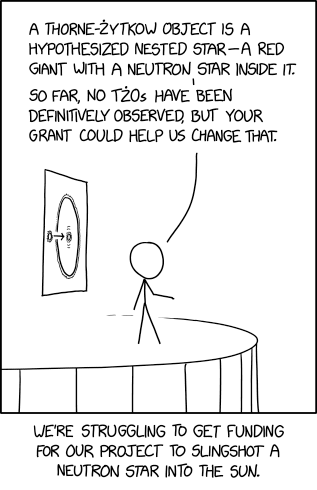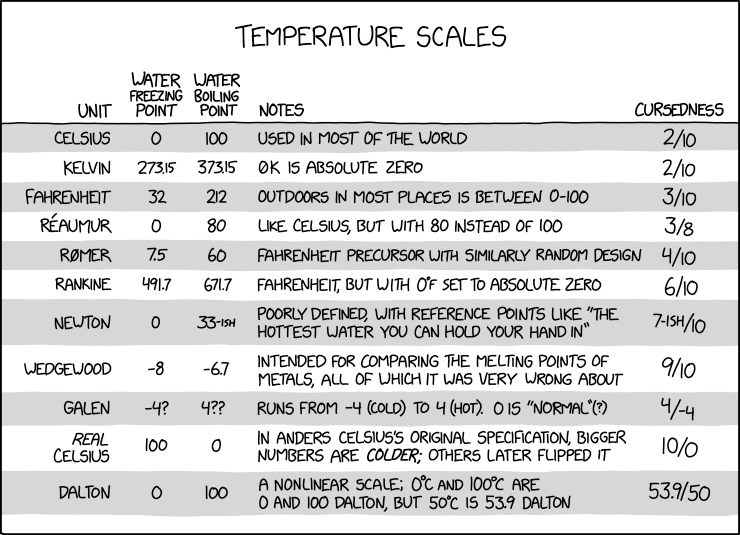Sounds like the Enormous Baloth:
Its diet consists of fruits, plants, small woodland animals, large woodland animals, woodlands, fruit groves, fruit farmers, and small cities.
Sounds like the Enormous Baloth:
Its diet consists of fruits, plants, small woodland animals, large woodland animals, woodlands, fruit groves, fruit farmers, and small cities.
Mr. Munroe has a little vignette at the top of the page that depicts Cueball putting up a “Vote Harris” lawn sign. Is this new, or have I just been inattentive?

Our experiment will be expensive, but we believe it will produce important spin-offs, especially if we manage to hit the sun from the right angle.
Happy 3000th comic, Randall.
Mr. Munroe has a little vignette at the top of the page that depicts Cueball putting up a “Vote Harris” lawn sign. Is this new, or have I just been inattentive?
FWIW I noticed it yesterday morning (Fri 10/18). Was it there much before then? I can’t say.
Ref the latest comic, I presume that’s Dr. Thorne standing there on stage with Dr. Żytkow waiting in the wings to take the Q&A.
Nah, Thorne has a pretty distinctive beard that I don’t think Munroe would have passed up on drawing (he looks about as much like a wizard as anyone not wearing a robe can).
I had assumed those were made-up names, not real scientists. Time for me to consult wiki. Thanks for the point-out.
But I do think the idea of the guys naming the phenomenon they hope to create after themselves has a certain academic panache.
Kip Thorne is certainly the most prominent living astrophysicist, and a strong contender for the title of smartest person in the world. He won the Nobel Prize a few years back for his work on gravitational wave detectors, and he was the primary science advisor for the movie Interstellar, where his greatest-in-the-world expertise on wormholes was relevant. He’s also made some famous wagers with a variety of other physicists, including several with Hawking (all of which he won).
Anna Żytkow isn’t nearly as well known. Most of her work consists of these objects, plus some work on Kuiper-belt objects.

In my new scale, °X, 0 is Earths' record lowest surface temperature, 50 is the global average, and 100 is the record highest, with a linear scale between each point and adjustment every year as needed.
Amazingly, all of those are real.
I don’t see why Rankine is +3 on the cursedness scale vs Fahrenheit, while Kelvin remains the same vs. Celsius. Kelvin actually makes Celsius look worse in retrospect; the relationship with water now looks silly. Rankine is the same, except that it wasn’t originally based on the characteristics of (fresh) water.
Kinda dumb that we don’t have a scale where putting one joule into one gram of water raises the temp by one degree. Basically, Kelvin times 4.184.
He could have mentioned the technical distinction between Celsius and centigrade.
technical distinction between Celsius and centigrade
Right. One’s abbreviated with a C and the other is abbreviated with a C.
I don’t see why Rankine is +3 on the cursedness scale vs Fahrenheit, while Kelvin remains the same vs. Celsius. Kelvin actually makes Celsius look worse in retrospect; the relationship with water now looks silly. Rankine is the same, except that it wasn’t originally based on the characteristics of (fresh) water.
Semi-serious answer to a semi-silly question …
IMO … Celcius and Kelvin have offsetting advantages and offsetting penalties which are declined with no loss of down. Kelvin is the most logical, while Celsius is the most popular. Collectively that’s a tie on the overall balance of measure of (de)merit.
OTOH Fahrenheit is unpopular (on a planetary scale) and innumerate. But somewhat used. While Rankine is unpopular, innumerate, and universally unused. A triple whammy of fail. Hence earning a much higher cursedness index.
IMO Rankine has always been most useful as the answer to a fake IQ test question: Celsius is to Kelvin as Fahrenheit is to [_________]. IOW it was invented to fill in the fourth box on the 2x2 grid. Because scientists abhor a vacuum they can fill with a published paper. And always have. Professor Rankine was no exception.
If Munroe was really on the ball he’d have given Rankine’s cursedness index as the same 6/10 value but expressed with a denominator of 180. So 108/180. ![]()
If cursedness is just antipopularity, I’d agree with your analysis. I’m viewing it through a different lens, but maybe that’s not what Munroe is doing.
Rankine isn’t really less logical than Kelvin. They both win points by being zero at absolute zero. And they both lose because their scale factor is disconnected from anything relevant. So on that basis I’d say they’re about equal, and less cursed than either Celsius or Fahrenheit. I agree that Fahrenheit is a tiny bit more cursed than Celsius, though not by much, since basing the scale on the characteristics of water is still a bit parochial. It’s not even really true that the boiling point of water is 100 C. It’s off by a bit, since it’s actually based on the triple point of water.
Understood. On scientific merit there’s not a lot of light between Kelvin & Rankine. On practical merit in 21st century physics / engineering practice there’s a lot.
All of which brings up an interesting point / side diversion. To wit: What is the most logical temperature scale we can come up with? The one that all society and science should adopt forthwith?
ISTM in light of current knowledge, any temp scale not defining its zero point as absolute zero is utterly and unsalvageably flawed. So far so easy,
But what should be used to define the unit size? I like your water 1 gram 1 joule = 1 degree method. It sure fits amongst the rest of the rationale for derived SI units comfortably
But why water? And at what pressure under what mixture of gasses? Why liquid and not solid or gaseous state?
I’ll argue with no real conviction that the defining substance should be hydrogen not water. As a liquid, water has a lot of weird properties we don’t need to import into our temp scale. We also ought to define our system so it works in a vacuum since such a greater portion of Nature is just that: empty space devoid of pressurizing gas or gravity.
Probably you would have to do something like take the same wavelength of light used to define the second, relate it to temperature via the Boltzmann constant, and have each degree of temperature be one-whateverth of that was convenient. Still ultimately arbitrary but it might usefully tie temperature into our system of physical constants.
You could just set the Boltzmann constant to 1. Though it’s pretty small and it would be an inconvenient measure.
Maybe set it to 1 joule-mole per degree. The normal Boltzmann constant is ~10^-23, while a mole is ~10^23, so they sorta cancel themselves out.
If cursedness is just antipopularity, I’d agree with your analysis. I’m viewing it through a different lens, but maybe that’s not what Munroe is doing.
It’s not just antipopularity. But that’s one component of it.
You could just set the Boltzman constant to 1. Though it’s pretty small and it would be an inconvenient measure.
Tell picofarads I said hi!
Seriously, some units just work out to inconvenient sizes, that’s why we have prefixes.
Tell picofarads I said hi!
What’s kinda crazy is that with supercapacitors around now, everything from picofarads up to kilofarads are perfectly reasonable measures. I remember when a 1 F capacitor was obnoxiously large, like bigger than a soda can. But today they’re smaller than your pinky (though with some downsides).
Maybe set it to 1 joule-mole per degree.
Screwed this up. Should be joules per degree-mol. Which is in fact just the molar gas constant, which is 8.3 J/K-mol in SI units. Yocto-whatevers are annoying, but we can deal with a factor of <10x.